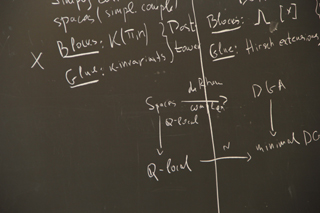In this section, Professor Haynes Miller describes the enrollment and structure of the course.

Notes from Lyubov Panchev's lecture during the 2014 offering of the Kan Seminar. (Photo courtesy of MIT OpenCourseWare.)
Student Enrollment
18.915 Graduate Topology Seminar (Kan Seminar) is offered every fall semester. It is geared toward graduate students in the mathematics department. Although the topic is Algebraic Topology, students from outside this field are welcome; anyone with sufficient background in algebraic topology may enroll. Often, students from Harvard cross-register to take the course, and occasionally, a graduate student from elsewhere spends a term at MIT for the express purpose of participating in the Kan Seminar. Occasionally, one or two undergraduates will enroll in the seminar. Total enrollment is typically 7–10 students. Generally auditors are discouraged or forbidden. In this particular
semester, unusually, several students dropped the course after several weeks. We welcomed them back if they wished to attend some of the talks later.
Course Components
Each participant reports on three seminal papers in algebraic topology over the course of the semester. These talks are generally an hour in length and occur during the regular meeting time for the course (typically 1 hour per session 3 times per week). Each talk is preceded by a student-organized "practice talk," to which the participants are invited but the instructor is not. After the formal talk, the instructor debriefs with the speaker during office hours, discusses the mathematics and the presentation, and helps the speaker decide on his or her next paper. Each participant must submit a "reading response" to each paper he or she is not reporting on, in advance of the talk, either on paper or by email. The instructor replies to each reading response. Additionally, the instructor meets individually with each participant for about a half hour outside of class to discuss the mathematics surrounding the paper he or she will report on next.
